

| Welcome | Database | Indexes | Copyright/Disclaimer | Login |
Kevin
Mackay
SKINNER, OAM
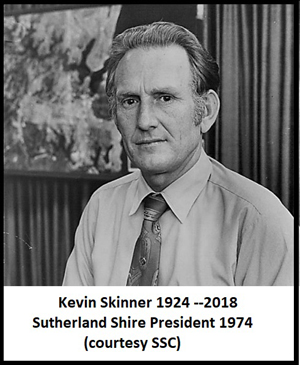
Written by Elizabeth Craig
for Sutherland Shire Historical Society Bulletin No.209, November 2018
Two phrases
often used to describe this popular long-serving former Councillor and Shire
President are ‘passionate about Sutherland Shire’, and ‘one of Sutherland
Shire’s greatest leaders’.
Born in
Mackay, in Queensland in 1924, Kevin, the youngest of nine children, was three
months old when he lost his father after a motorbike accident. The local
community rallied, holding fundraising functions for the family, raising enough
money for Kevin’s mother to buy a house. A religious woman, she bought Evandale,
a farmhouse on acreage attached to a Seventh Day Adventist estate in Cooranbong
near Newcastle. Here the family were self-sufficient with an orchard, vegetable
garden and cows, as well as the support of the church. ‘We all had jobs to do,’
recalled Kevin, ‘Mine was to pick up morning wood or kindling from under trees
to light the fires.’ When the jobs were done the children could run wild – and
did. ’We explored all the bush for miles around, up the hills and in the creeks.
We couldn’t have had a better life.’
The
children went to the primary school at Cooranbong, but because of hernias which
needed treating, Kevin didn’t start school until he was eight. At about this
time Kevin’s mother became restless and for the next few years the family had
several moves around the Central coast area.
The children were enterprising. At Brisbane Waters their landlord sold
them a boat for £2 which they paid off at 2/- a week by selling cow manure to
asparagus farmers and digging worms to sell to fishermen. By sixth class, Kevin
had attended six schools. The family then moved to Hamilton so that the children
still at home could go to a church high school.
At 16, Kevin
and his mother moved to Wahroonga in Sydney (the others had left home). When she
was widowed for the second time, Kevin left school to help support his mother.
He first worked on a pig farm at West Pennant Hills, getting up at 3.00am to
feed the pigs, and later on a flower farm and market garden. Then a friend was
leaving for New Zealand. He had a window cleaning business and offered Kevin his
Indian motorbike and step ladders to take over the business, working around
Haberfield. ‘I earned about ten times as much as I had on the pig farm,’ said
Kevin.
In 1945,
while on home leave, Kevin attended a recreational picnic at Clifton Gardens.
Here he met his future wife, Gwen Bulmer who was from Bexley. They married four
months later, and Kevin was discharged from the army in August 1946.
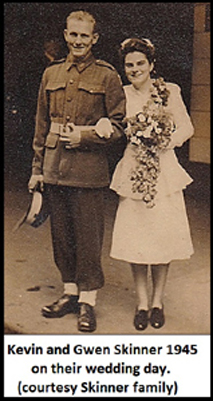
Gwen’s father, a carpenter, was a great support to the young couple, and when Kevin spoke to him about his job prospects, he commented, ‘I don’t think you’d make a carpenter, but plumbers do a bit of everything. Why don’t you try that.’ He did. He applied to do a Commonwealth Reconstruction Training Scheme (CRTS) set up by the government trade union movement. Kevin had to wait for four years to do the CRTS, but meanwhile he studied at St George Tech at night and got his drainers’ licence, working on weekends. After finishing the CRTS and working for a licenced plumber, he eventually got his licence and went into business for himself. Meanwhile, to expand his skills he did courses in carpentry, bricklaying and pressure welding.
When he saw
an advertisement for a plumbing inspector at the Water Board, Kevin applied for
and got the job. He continued with extra studies, doing a management course.
Plumbing systems were in the throes of change and he enjoyed testing new
programs and teaching them to other inspectors. Kevin was on the Water Board for
29 years and 9 months, finishing as Chief Inspector of Water Conservation.
Kevin and
Gwen visited a friend, Bob Sims, in Soldiers Road, Jannali. They loved the rural
area. ‘It was Spring and very pretty with the wildflowers out,’ he recalled.
When a block became available in Mitchell Avenue, right beside the railway
station they bought it for £68, paying it off at £3 per week. It was a lot of
money, as nothing was saved after paying living expenses. Like everyone else in
the army, Kevin smoked in those days and Gwen kept the budget for everything,
including tobacco for Kevin’s smoking.
Jannali had a
small shopping centre in that early post-war period.
Joe Cary’s Butcher Shop was on the
western side of the line, and a small mixed business on the corner. Across the
line was Fishers’ general store, post office and banking agency. Mail was
delivered on horseback by Mrs Larkin. The Fisher family had been there for a
long time, and their son Rod became a local doctor.
It was this
pioneering spirit which led Jannali residents to chip in and build an RSL hall
on land leased from the Council. ’That became the focal point of all the good
times,’ recalled Kevin. ‘We had dances there. It was a happy group of people.’
On Friday nights it was men’s night while the women stayed home to mind
the kids. ‘Men needed to get together, to talk, to reminisce,’ says Gwen. They
played cards, or darts. ‘It was really good.’
Politics
Kevin first
became interested in politics in the early 1950s. He was a delegate to the RSL’s
Southern Metropolitan District Council which held meetings in Mortdale. Here he
met and became good friends with people on both sides of the political fence.
They included Labor men like Gough Whitlam (later Australian Prime Minster) and
Arthur Gietzelt (who became Sutherland Shire President and then Federal Minister
for Veterans Affairs), and Liberal followers, including Ray Watson (later a
Shire Councillor) and a Sutherland solicitor. ‘That taught me that even if you
were on opposing sides in political parties you gained far more by discussion
and dialogue than if you tried to belt your ideas into their heads,’ remarked
Kevin.
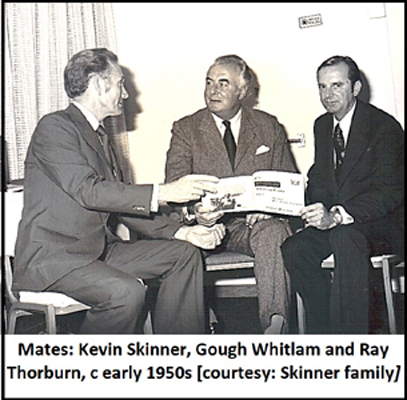
Work with
Sutherland Shire Council
Kevin Skinner
did make vast improvements in conditions for volunteer bushfire fighters, but
his first role on election to Council, was as member of the Parks and
Playgrounds Committee. With two children of his own, Ross and Robyn, he was very
aware of the lack of sporting facilities for kids in the Shire. Women’s sports
were totally neglected, and there was no tenure of grounds for sporting clubs.
He set about to change that situation, and when he was appointed Chairman of the
Parks and Playgrounds and the Sports Advisory committees, he convinced Council
to approve the secure allocation of grounds for sporting clubs in return for the
Clubs helping to manage and maintain the grounds.
More than 60
new sports grounds were allocated between 1964 and 1971. One Kevin found most
satisfying was Bellingarra, allocated to women’s netball. Lack of available
funds to put facilities on the grounds did not deter him. Using his plumbing
skills, and with the voluntary help of former plumbers and others, he put in
toilets and sewers, thus saving hundreds of dollars.
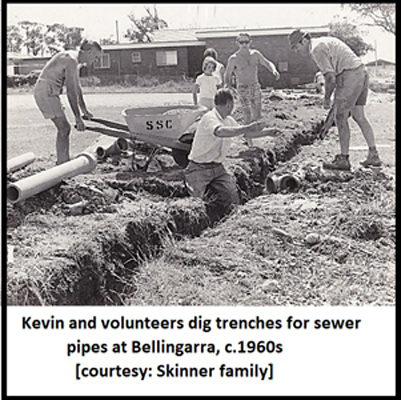
Waratah Park complex was another project Kevin was proud
of. It catered for several codes – athletics, soccer, Rugby League, Aussie Rules
and tennis as well as the swimming pool. A closed bike circuit was built around
the park. Kevin organized through Council that a bee garden be established there
so that bee keepers had somewhere to raise Queen bees. A small museum was
eventually built and people from school kids to retirees come through in buses
to learn how bees are raised and honey is formed. ‘That is a real success
story,’ remarked Kevin.
The catalyst
to improving conditions for bushfire fighters
In 1968 Kevin
was involved in the worst fire in the Shire’s then recorded history, causing a
state of emergency to be declared. ‘Most of the Shire was in flames,’ recalled
Kevin. He told of his nightmare journey, driving with other volunteers through
Bundeena with flames all around them, and having to kick fallen burning trees
off the road to get the vehicle through. ‘It was a scene of absolute
devastation,’ he said. They eventually got to Audley and were called to Engadine
where the fire had jumped the railway line, the railway station was burning and
attempts were being made to save nearby houses.
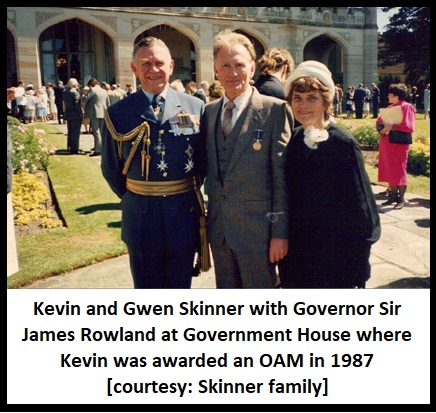
Gwen
Skinner, Kevin’s beloved wife and support for 69 years, passed away on 26 May
2014.
Kevin Skinner retired from
service on Sutherland Shire Council in 1987. That year he was awarded an OAM for
his service to local government.
He was chosen as one of the 100 ‘Faces of the
Shire in the Council’s centenary celebration in 2006.
Councillor Peter Scaysbrook probably summed it up for
everyone when he said earlier this year that Kevin, ‘… was of an era that has
probably gone forever, but he will remain an inspiration to us all.’
To
hear interviews with Kevin Skinner in full, contact the Local Studies Librarian
at Sutherland Library and arrange a time to listen to them.